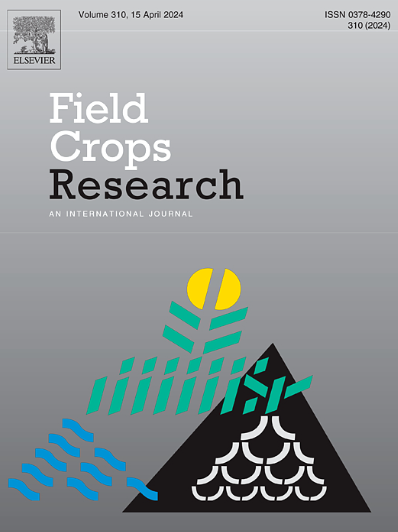高效的根系氮转运是提高半矮秆油菜氮素利用率和产量的关键因素
IF 5.6
1区 农林科学
Q1 AGRONOMY
引用次数: 0
摘要
合理配置氮肥施用量和种植密度是提高油菜籽产量的关键。但施氮量的增加会降低氮素利用效率(NUE),种植密度的增加会增加倒伏风险,从而限制了生产效益。矮秆型和致密型油菜品种抗倒伏能力强,但产量潜力低,而常规株型品种产量高,但在密集种植条件下易发生倒伏。利用不同植株结构材料的优势提高油菜籽氮素利用率和产量的研究有限。本文章由计算机程序翻译,如有差异,请以英文原文为准。
Efficient root nitrogen transport is a key factor in improving nitrogen utilization and yield of semi-dwarf rapeseed
Context
Rational allocation of nitrogen (N) application rates and planting densities is crucial for improving rapeseed yield. However, an increased N application rate reduces N use efficiency (NUE), and a higher planting density elevates the risk of lodging, thus limiting production benefits. Dwarf and compact rapeseed varieties exhibit high lodging resistance but possess low yield potential, while cultivars with conventional plant architecture possess high yield potential but are susceptible to collapse under dense planting. Limited research exists on utilizing the advantages of materials with different plant architectures to enhance N utilization and yield in rapeseed.
Methods
The experiment was conducted using the dwarf mutant HS5sca, the tall wild-type HS5, and their F1 semi-dwarf and compact hybrid HS5+/sca all sharing the same genetic background from 2019 to 2022. The field experiment used a split-split-plot design with three different planting densities (D1, D2, and D3: 15 × 10⁴, 45 × 10⁴, and 75 × 10⁴ plants ha⁻¹) and three different N application rates (N1, N2, and N3: 120, 240, and 360 kg ha⁻¹) to find out how N application rate and planting density affected NUE and yield in different genotypes.
Results
With increasing N rate and planting density, the expression levels of nitrate transporter-encoding genes, BnaC08.NPF6.3 and BnaA07.NPF4.6, in roots increased first and then decreased in HS5sca and HS5+/sca, reaching the peak at N2 and D2, respectively, while in HS5 they increased with increasing N rate and increased first and then decreased with increasing planting density. Meanwhile, the activities of nitrate reductase, nitrite reductase, glutamine synthetase, and glutamate synthase in roots of the three genotypes at the flowering stage increased with increasing N rate, while these enzyme activities increased first and then decreased with increasing planting density. These enzyme activities increased N and dry matter accumulation in both roots and shoots, as well as a higher N contribution rate (NCR). Despite declines in agronomic NUE (aNUE) and the partial factor productivity of N (PFPN) with increasing N rate, the relative growth rates of root and shoot increased, positively affecting yields under most of the treatments. Conversely, NCR and aNUE decreased, while root and shoot N, dry matter accumulation, PFPN and, yield initially increased and then decreased with increasing planting density. Compared with N1, the average yield over three years for HS5sca, HS5+/sca, and HS5 increased by 24.5 %, 22.1 %, and 14.6 % at N2, and 8.1 %, 10.2 %, and 4.6 % under D2 compared to D1, respectively. Among the three genotypes, HS5+/sca exhibited higher expression of nitrate transporter genes, greater N metabolism-related enzyme activities, increased shoot N accumulation, and higher NUE than both parent lines across different N application rates and planting densities.
Conclusion
At an N application rate of 240 kg ha⁻¹ and planting densities of 45–75 × 10⁴ plants ha⁻¹ , HS5+/sca demonstrated an average yield increase of 11.2 % over three years, with greater yield potential and NUE compared to other N rate-planting density treatments.
求助全文
通过发布文献求助,成功后即可免费获取论文全文。
去求助
来源期刊

Field Crops Research
农林科学-农艺学
CiteScore
9.60
自引率
12.10%
发文量
307
审稿时长
46 days
期刊介绍:
Field Crops Research is an international journal publishing scientific articles on:
√ experimental and modelling research at field, farm and landscape levels
on temperate and tropical crops and cropping systems,
with a focus on crop ecology and physiology, agronomy, and plant genetics and breeding.
 求助内容:
求助内容: 应助结果提醒方式:
应助结果提醒方式:


